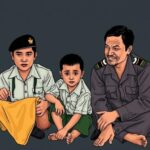Myanmar’s Civil War Intensifies Amid Military Conscription and Resistance Growth
Since the military coup in February 2021, Myanmar’s civil war has escalated, characterized by aggressive conscription laws, shifting military strategies, and the emergence of unified ethnic resistance groups. This has led to significant humanitarian challenges and increased regional instability, with individuals like Chaw Su highlighting the devastating personal impact of the conflict.
The civil conflict in Myanmar has intensified markedly since the military coup in February 2021, which led to the overthrow of the democratically elected government of Aung San Suu Kyi. The recent evolution of the conflict encompasses military innovations, shifts in tactics, and the rise of new resistance groups. Notably, the junta’s decision to enforce conscription highlights their desperation as they struggle to replenish dwindling troop numbers amid significant territorial losses and resistance from various insurgent groups such as the People’s Defense Forces (PDF) and multiple ethnic armed organizations. The introduction of compulsory military service for men aged 18 to 35 and women aged 18 to 27, effective February 2024, has faced backlash from the populace. Chaw Su, who lost her husband shortly after his conscription, lamented, “We were always poor and struggled, but life was much more bearable with him.” This personal tragedy reflects the broader toll of the conflict on families as they cope with the loss of primary earners. As the fabric of the society frays under this pressure, the military is adapting its strategy to include urban combat, reflecting a shift from guerrilla warfare to more conventional military tactics. The Tatmadaw currently controls only about one-third of its previous territory as it faces coordinated strikes from various ethnic armed groups, notably highlighted by Operation 1027. Historical context reveals that Myanmar’s civil conflict has been ongoing since its independence from British colonial rule in 1948, evolving over time from guerrilla tactics to include modern military strategies. Resistance groups have shown adaptability, utilizing contemporary technologies such as drones for reconnaissance and targeting, which changes dynamics on the battlefield. Despite disproportionate resources favoring the Tatmadaw, insurgent forces have sustained momentum through innovative techniques and tactics. Moreover, the National Unity Government (NUG), comprised of ousted officials and allied leaders, has sought to unify diverse ethnic factions against the military junta. The collaborative efforts of groups such as the Arakan Army and the Ta’ang National Liberation Army, amongst others, have resulted in substantial resistance operations aimed at reclaiming various territories from military control. The humanitarian crisis has further exacerbated due to displacement and migration across borders into countries like Thailand and India. The wider region, including China, is grappling with increased refugee numbers, raising concerns over stability and the situation’s implications on cross-border organized crime networks. Though the NUG and its armed wing, the PDF, are expanding influence, the Tatmadaw continues to rely on advanced weaponry and military tactics. Yet, mandatory conscription and reliance on inexperienced recruits have not sufficiently stemmed the onslaught from resistant forces, further revealing the military’s operational vulnerabilities. The prevailing public sentiment against the junta and the passion among rebel factions illustrate the moral dilemmas surrounding conscription, complicating the landscape of the conflict for all involved. With ongoing tensions and an urgent humanitarian need, the resilience evident among communities indicates potential instability for the junta, necessitating continued global attention and support toward the preservation of human rights and peace in Myanmar.
Myanmar has experienced persistent civil conflict since gaining independence in 1948, with the current war escalating dramatically after the military coup in February 2021. The coup resulted in the ousting of Aung San Suu Kyi’s democratically elected government and has led to heightened military aggression, including compulsory conscription amidst significant territorial and tactical losses. The conflict represents a complex interplay of traditional guerrilla warfare transitioning into more sophisticated military strategies involving ethnic resistance groups, highlighting the humanitarian repercussions and regional instability that accompany the ongoing strife.
Myanmar’s civil war is at a critical juncture, with the junta’s reliance on conscription revealing its desperation amidst intensified resistance. The evolution of combat tactics and emerging alliances among ethnic groups signify a dynamic conflict landscape, complicating military undertakings. The humanitarian crisis underscores an urgent need for support, as the resilience among the populace signals both profound challenges and potential for change as Myanmar navigates its tumultuous future.
Original Source: evrimagaci.org






Post Comment